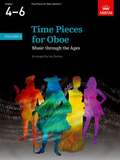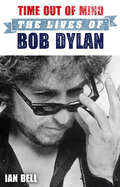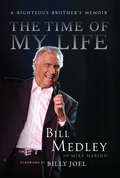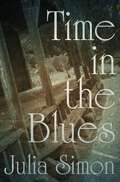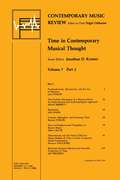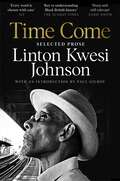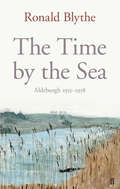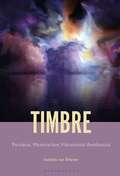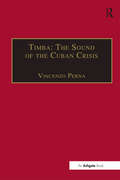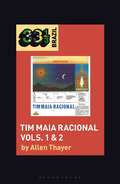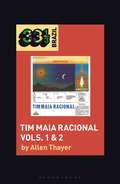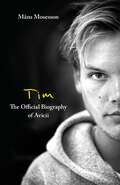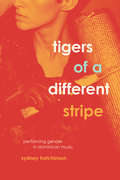- Table View
- List View
Time to Say Hello: My Autobiography
by Katherine JenkinsThe UK's biggest-selling classical artist reveals how her angelic voice has shot her to superstardom...Katherine Jenkins is an international singing superstar who has redefined a music genre: she has brought classical music to the masses and inspired young and old with her incredible voice, her glamorous looks and, above all, her love for music, her country and her fans.Born in Neath, South Wales, Katherine won national acclaim as the BBC Welsh Choirgirl of the year and soon after a place at the Royal Academy of Music. Auditioning for a terrifying panel of industry experts at Universal Music she came away with the largest recording deal in classical music history. And so began Katherine's meteoric rise to stardom.TIME TO SAY HELLO is Katherine's incredible story. Packed with laughter, adventure, heartbreak and music, it is the tale of a dream coming true and one that will keep you gripped to the last note ¿
Time Pieces for Oboe, Volume 2: Music through the Ages (Time Pieces)
by AbrsmThe second of a two-volume anthology presenting attractive repertoire for oboe and piano from the sixteenth century to the present day. Each volume presents the pieces in chronological order and prints the year in which they were written, giving a feel of different styles of music through time.
Time Out of Mind: The Lives of Bob Dylan
by Ian BellBy the middle of the 1970s, Bob Dylan’s position as the pre-eminent artist of his generation was assured. The 1975 album Blood on the Tracks seemed to prove, finally, that an uncertain age had found its poet.Perverse or driven, Dylan refused the role. By the decade’s end, the counter-culture’s poster child had embraced conservative, evangelical Christianity. Fans and critics alike were confused; many were aghast. Still the hits kept coming.Then Dylan faltered. His instincts, formerly unerring, deserted him. In the 1980s, what had once appeared unthinkable came to pass: the ‘voice of a generation’ began to sound irrelevant, a tale told to grandchildren.Yet in the autumn of 1997 something remarkable happened. Having failed to release a single new song in seven long years, Dylan put out the equivalent of two albums in a single package. He called it Time Out of Mind. So began the renaissance, artistic and personal, that culminated in 2012’s acclaimed Tempest.In the concluding volume of his groundbreaking study, Ian Bell explores the unparalleled second act in a quintessentially American career. It is a tale of redemption, of an act of creative will against the odds, and of a writer who refused to fade away.Time Out of Mind is the story of the latest, perhaps the last, of the many Bob Dylans. This one might yet turn out to have been the most important of them all.
The Time of My Life: A Righteous Brother's Memoir
by Bill MedleyFrom an early age, Bill Medley had a passion for music. School glee club and amateur singing contests soon gave way to the albums of Ray Charles and Little Richard. That raw R&B influence would profoundly shape Medley's musical future.As the pioneering "blue-eyed soul” group the Righteous Brothers, Bill Medley and late partner Bobby Hatfield sang such huge hits as "(You're My) Soul and Inspiration,” "Unchained Melody,” and "You've Lost That Lovin' Feelin',” the latter recognized by BMI as the most-played song of the twentieth century. Medley's duet with Jennifer Warnes for the Dirty Dancing soundtrack, "(I've Had) the Time of My Life,” became a worldwide No. 1 single on its way to winning an Oscar, a Grammy, and a Golden Globe.But Medley's story isn't just about the hits and the awards. It's about an immensely talented man who reached the pinnacle of fame, success, and excess, until the shocking murder of his wife, Karen. In time, this tragedy eventually helped him renew his commitment to both faith and family.
The Time of My Life: A Righteous Brother's Memoir
by Bill MedleyFrom an early age, Bill Medley had a passion for music. School glee club and amateur singing contests soon gave way to the albums of Ray Charles and Little Richard. That raw R&B influence would profoundly shape Medley's musical future.As the pioneering "blue-eyed soul” group the Righteous Brothers, Bill Medley and late partner Bobby Hatfield sang such huge hits as "(You're My) Soul and Inspiration,” "Unchained Melody,” and "You've Lost That Lovin' Feelin',” the latter recognized by BMI as the most-played song of the twentieth century. Medley's duet with Jennifer Warnes for the Dirty Dancing soundtrack, "(I've Had) the Time of My Life,” became a worldwide No. 1 single on its way to winning an Oscar, a Grammy, and a Golden Globe.But Medley's story isn't just about the hits and the awards. It's about an immensely talented man who reached the pinnacle of fame, success, and excess, until the shocking murder of his wife, Karen. In time, this tragedy eventually helped him renew his commitment to both faith and family.
Time in the Blues
by Julia SimonSpontaneity, immediacy and feeling characterize the blues as a genre. Whether it's the movement of call and response, the expressive bends and wails of voice and instruments or the synergistic relationship between audience and performers, the blues embody a kind of "living in the moment" aesthetic. At the same time, the blues genre has always responded in a unique way to its historical moment, its formal characteristics, figures, and devices constantly emerging from--and speaking to--the social relations emanating from Jim Crow segregation, sharecropping, racist violence, and migration. Time in the Blues presents an interdisciplinary analysis of the specific forms of temporality produced by and reflected in the blues. Examining time as it is represented, enacted, and experienced through the blues, interdisciplinary scholar Julia Simon addresses how the material conditions in the early twentieth century shaped a musical genre. The technical aspects of the blues--ostinato patterns, cyclical changes, improvisation, call and response--emerge from and speak to the Jim Crow era's economic, social, and political relations. Through this temporal analysis, Simon addresses how the moment-to-moment aspect of time in blues performance relates to the genre's location within historical time, with careful examinations of the historical performance and reception of blues music from the 1920s to the present day. Simon examines the structuring of time, and analyzes temporality to open the broader questions of desire, agency, self-definition, faith, and forms of resistance as they are articulated in this music. Ultimately, Time in the Blues, argues for the relevance, significance, and importance of time in the blues for shared values of community and a vision of social justice.
Time in the Blues
by Julia SimonSpontaneity, immediacy and feeling characterize the blues as a genre. Whether it's the movement of call and response, the expressive bends and wails of voice and instruments or the synergistic relationship between audience and performers, the blues embody a kind of "living in the moment" aesthetic. At the same time, the blues genre has always responded in a unique way to its historical moment, its formal characteristics, figures, and devices constantly emerging from--and speaking to--the social relations emanating from Jim Crow segregation, sharecropping, racist violence, and migration. Time in the Blues presents an interdisciplinary analysis of the specific forms of temporality produced by and reflected in the blues. Examining time as it is represented, enacted, and experienced through the blues, interdisciplinary scholar Julia Simon addresses how the material conditions in the early twentieth century shaped a musical genre. The technical aspects of the blues--ostinato patterns, cyclical changes, improvisation, call and response--emerge from and speak to the Jim Crow era's economic, social, and political relations. Through this temporal analysis, Simon addresses how the moment-to-moment aspect of time in blues performance relates to the genre's location within historical time, with careful examinations of the historical performance and reception of blues music from the 1920s to the present day. Simon examines the structuring of time, and analyzes temporality to open the broader questions of desire, agency, self-definition, faith, and forms of resistance as they are articulated in this music. Ultimately, Time in the Blues, argues for the relevance, significance, and importance of time in the blues for shared values of community and a vision of social justice.
Time in Contemporary Musical Thought (Contemporary Music Review)
by Jonathan D. KramerFirst Published in 1993. Routledge is an imprint of Taylor & Francis, an informa company.
Time in Contemporary Musical Thought (Contemporary Music Review #Vols. 7, Pts. 2)
by Jonathan D. KramerFirst Published in 1993. Routledge is an imprint of Taylor & Francis, an informa company.
Time Come: Selected Prose
by Linton Kwesi Johnson‘Key to understanding Black British history’ – The Sunday Times‘Sharp and still relevant’ – Zadie SmithOne of the great poets of modern times, and a deeply respected political and cultural activist and social critic, Linton Kwesi Johnson is also a prolific writer of non-fiction. In Time Come, he selects some of his most powerful prose – book and music reviews published in newspapers and magazines, lectures, obituaries and speeches – for the first time. Written over many decades, these works draw on Johnson’s own Jamaican roots and on Caribbean history to explore the politics of race that continue to inform the Black British experience.Ranging from reflections on the place of music in Caribbean and Black British culture as a creative, defiant response to oppression, to penetrating appraisals of novels, films, poems and plays, and including warm tributes paid to the activists and artists who inspired him to contribute to the struggle for racial equality and social justice, Time Come is a panorama of an exceptional life. Venturing into memoir, it underscores Johnson’s enduring importance in Britain’s cultural history and reminds us of his brilliant, unparalleled legacy.With an introduction by Paul Gilroy, author of There Ain’t No Black in the Union Jack.‘A mosaic of wise, urgent and moving pieces’ – Kit de Waal‘As necessary as ever’ – The Observer‘A book to be savoured and re-read’ – Derek Owusu‘An outstanding collection’ – Caryl Phillips‘A necessary book from a writer who continues to inspire’ – Yomi Sode‘Incisive, engaging, fearless’ – Gary Younge
The Time by the Sea: Aldeburgh 1955-1958
by Dr Dr Ronald BlytheThe Time by the Sea is about Ronald Blythe's life in Aldeburgh during the 1950s. He had originally come to the Suffolk coast as an aspiring young writer, but found himself drawn into Benjamin Britten's circle and began working for the Aldeburgh Festival. Although befriended by Imogen Holst and by E M Forster, part of him remained essentially solitary, alone in the landscape while surrounded by a stormy cultural sea. But this memoir gathers up many early experiences, sights and sounds: with Britten he explored ancient churches; with the botanist Denis Garrett he took delight in the marvellous shingle beaches and marshland plants; he worked alongside the celebrated photo-journalist Kurt Hutton. His muse was Christine Nash, wife of the artist John Nash. Published to coincide with the centenary of Britten's birth, this is a tale of music and painting, unforgettable words and fears. It describes the first steps of an East Anglian journey, an intimate appraisal of a vivid and memorable time.
Timbre: Paradox, Materialism, Vibrational Aesthetics
by Isabella Van ElferenTimbre is among the most important and the most elusive aspects of music. Visceral and immediate in its sonic properties, yet also considered sublime and ineffable, timbre finds itself caught up in metaphors: tone “color”, “wet” acoustics, or in Schoenberg's words, “the illusory stuff of our dreams.” This multi-disciplinary approach to timbre assesses the acoustic, corporeal, performative, and aesthetic dimensions of tone color in Western music practice and philosophy. It develops a new theorization of timbre and its crucial role in the epistemology of musical materialism through a vital materialist aesthetics in which conventional binaries and dualisms are superseded by a vibrant continuum. As the aesthetic and epistemological questions foregrounded by timbre are not restricted to isolated periods in music history or individual genres, but have pervaded Western musical aesthetics since early Modernity, the book discusses musical examples taken from both “classical” and “popular” music. These range, in “classical” music, from the Middle Ages through the Baroque, the belcanto opera and electronic music to saturated music; and, in “popular” music, from indie through soul and ballad to dark industrial.
Timbre: Paradox, Materialism, Vibrational Aesthetics
by Isabella Van ElferenTimbre is among the most important and the most elusive aspects of music. Visceral and immediate in its sonic properties, yet also considered sublime and ineffable, timbre finds itself caught up in metaphors: tone “color”, “wet” acoustics, or in Schoenberg's words, “the illusory stuff of our dreams.” This multi-disciplinary approach to timbre assesses the acoustic, corporeal, performative, and aesthetic dimensions of tone color in Western music practice and philosophy. It develops a new theorization of timbre and its crucial role in the epistemology of musical materialism through a vital materialist aesthetics in which conventional binaries and dualisms are superseded by a vibrant continuum. As the aesthetic and epistemological questions foregrounded by timbre are not restricted to isolated periods in music history or individual genres, but have pervaded Western musical aesthetics since early Modernity, the book discusses musical examples taken from both “classical” and “popular” music. These range, in “classical” music, from the Middle Ages through the Baroque, the belcanto opera and electronic music to saturated music; and, in “popular” music, from indie through soul and ballad to dark industrial.
Timba: The Sound of the Cuban Crisis
by Vincenzo PernaCuban music is recognized unanimously as a major historical force behind Latin American popular music, and as an important player in the development of US popular music and jazz. However, the music produced on the island after the Revolution in 1959 has been largely overlooked and overshadowed by the Buena Vista Social Club phenomenon. The Revolution created the conditions for the birth of a type of highly sophisticated popular music, which has grown relatively free from market pressures. These conditions premised the new importance attained by Afro-Cuban dance music during the 1990s, when the island entered a period of deep economic and social crisis that has shaken Revolutionary institutions from their foundations. Vincenzo Perna investigates the role of black popular music in post-Revolutionary Cuba, and in the 1990s in particular. The emergence of timba is analysed as a distinctively new style of Afro-Cuban dance music. The controversial role of Afro-Cuban working class culture is highlighted, showing how this has resisted co-optation into a unified, pacified vision of national culture, and built musical bridges with the transnational black diaspora. Musically, timba represents an innovative fusion of previous popular and folkloric Afro-Cuban styles with elements of hip-hop and other African-American styles like jazz, funk and salsa. Timba articulates a black urban youth subculture with distinctive visual and choreographic codes. With its abrasive commentaries on issues such as race, consumer culture, tourism, prostitution and its connections to the underworld, timba demonstrates at the 'street level' many of the contradictions of contemporary Cuban society. After repeatedly colliding with official discourses, timba has eventually met with institutional repression. This book will appeal not only to ethnomusicologists and those working on popular music studies, but also to those working in the areas of cultural and Black studies, anthropology, Latin American st
Timba: The Sound of the Cuban Crisis
by Vincenzo PernaCuban music is recognized unanimously as a major historical force behind Latin American popular music, and as an important player in the development of US popular music and jazz. However, the music produced on the island after the Revolution in 1959 has been largely overlooked and overshadowed by the Buena Vista Social Club phenomenon. The Revolution created the conditions for the birth of a type of highly sophisticated popular music, which has grown relatively free from market pressures. These conditions premised the new importance attained by Afro-Cuban dance music during the 1990s, when the island entered a period of deep economic and social crisis that has shaken Revolutionary institutions from their foundations. Vincenzo Perna investigates the role of black popular music in post-Revolutionary Cuba, and in the 1990s in particular. The emergence of timba is analysed as a distinctively new style of Afro-Cuban dance music. The controversial role of Afro-Cuban working class culture is highlighted, showing how this has resisted co-optation into a unified, pacified vision of national culture, and built musical bridges with the transnational black diaspora. Musically, timba represents an innovative fusion of previous popular and folkloric Afro-Cuban styles with elements of hip-hop and other African-American styles like jazz, funk and salsa. Timba articulates a black urban youth subculture with distinctive visual and choreographic codes. With its abrasive commentaries on issues such as race, consumer culture, tourism, prostitution and its connections to the underworld, timba demonstrates at the 'street level' many of the contradictions of contemporary Cuban society. After repeatedly colliding with official discourses, timba has eventually met with institutional repression. This book will appeal not only to ethnomusicologists and those working on popular music studies, but also to those working in the areas of cultural and Black studies, anthropology, Latin American st
Tim Maia's Tim Maia Racional Vols. 1 & 2 (33 1/3 Brazil)
by Allen ThayerAt the height of Tim Maia's soaring fame, he joined a radical, extraterrestrial-obsessed cult and created two plus albums of some of Brazil's-and the globe's-best funk and soul music. This book explores the career of the man often hailed as the James Brown or Barry White of Brazil, and the time of his radical transformation from a musician notorious for hedonistic living to a devoted follower of Manoel Jacinto Coelho's Rational Culture.After suddenly joining Coelho's cult in 1974 (which started first as an offshoot of the mystical Afro-Brazilian religion Umbanda), Maia gave up drugs and alcohol, threw away his material possessions, and released Racional Vols. 1 & 2 in the attempt to convert the entirety of Brazil and the world to the revelation of Rational Culture. Thayer explores this strange, brief, yet incredibly prolific period of Maia's life wherein the reigning soul and funk artist of Brazil produced two albums, an EP, and a recently unearthed tape containing almost another full album of funky jams laced with spiritual content and scripture. For just as quickly as Maia became entranced with Coelho did he become disillusioned with the cult, disavowing and destroying everything having to do with that experience and refusing to speak of it for the rest of his life.33 1/3 Global, a series related to but independent from 33 1/3, takes the format of the original series of short, music-based books and brings the focus to music throughout the world. With initial volumes focusing on Japanese and Brazilian music, the series will also include volumes on the popular music of Australia/Oceania, Europe, Africa, the Middle East, and more.
Tim Maia's Tim Maia Racional Vols. 1 & 2 (33 1/3 Brazil Ser.)
by Mr Allen ThayerAt the height of Tim Maia's soaring fame, he joined a radical, extraterrestrial-obsessed cult and created two plus albums of some of Brazil's-and the globe's-best funk and soul music. This book explores the career of the man often hailed as the James Brown or Barry White of Brazil, and the time of his radical transformation from a musician notorious for hedonistic living to a devoted follower of Manoel Jacinto Coelho's Rational Culture.After suddenly joining Coelho's cult in 1974 (which started first as an offshoot of the mystical Afro-Brazilian religion Umbanda), Maia gave up drugs and alcohol, threw away his material possessions, and released Racional Vols. 1 & 2 in the attempt to convert the entirety of Brazil and the world to the revelation of Rational Culture. Thayer explores this strange, brief, yet incredibly prolific period of Maia's life wherein the reigning soul and funk artist of Brazil produced two albums, an EP, and a recently unearthed tape containing almost another full album of funky jams laced with spiritual content and scripture. For just as quickly as Maia became entranced with Coelho did he become disillusioned with the cult, disavowing and destroying everything having to do with that experience and refusing to speak of it for the rest of his life.33 1/3 Global, a series related to but independent from 33 1/3, takes the format of the original series of short, music-based books and brings the focus to music throughout the world. With initial volumes focusing on Japanese and Brazilian music, the series will also include volumes on the popular music of Australia/Oceania, Europe, Africa, the Middle East, and more.
Tim Book Two: Vinyl Adventures from Istanbul to San Francisco
by Tim BurgessTim Book Two is the follow-up to Telling Stories, the hugely successful memoir of Tim Burgess, singer of the Charlatans. In 2012, Tim published his hugely successful and critically acclaimed memoir, Telling Stories. Tim really enjoyed his new role as an author, and so here it is: Tim Book Two - a tale of Tim's lifelong passion for records, the shops that sell them, and the people who make them. In some ways, the biggest events in Tim's life happened in the couple of years after he had finished writing his first book rather than in the forty years before. So he had more to say, but instead of another autobiography he chose a different way of telling the story. Tim set himself a quest. He would get in touch with people he admired, and ask them to suggest an album for him to track down on his travels, giving an insight into what makes them tick. It would also offer a chance to see how record shops were faring in the digital age - one in which vinyl was still a much-treasured format.Tim assembled his cast of characters, from Iggy Pop to Johnny Marr, David Lynch to Cosey Fanni Tutti. Texts, phone calls, emails and handwritten notes went out. Here is the tender, funny and surprising story of what came back.
Tim – The Official Biography of Avicii
by Måns MosessonThe intimate biography of the iconic DJ who was lost too soon.Like a firework against the night sky, the DJ and producer Tim Bergling exploded onto the music scene. A musical visionary who, through his sense for melodies, came to define the era when Swedish and European house music took over the world.But Tim Bergling was also an introverted and fragile young man who was forced to grow up at an inhumanly fast pace. After a series of emergencies resulting in hospital stays, he stopped touring in the summer of 2016. Barely two years later, he took his own life.Tim - The Biography of Avicii is written by the award-winning journalist Måns Mosesson, who was given unique access to Tim's own notes, as well as interviews with Tim's family, friends and colleagues in the music business. The book paints an honest picture of Tim and his search in life, not shying from the difficulties that he struggled with.
Tigers of a Different Stripe: Performing Gender in Dominican Music (Chicago Studies in Ethnomusicology)
by Sydney HutchinsonTigers of a Different Stripe takes readers inside the unique world of merengue típico, a traditional music of the Dominican Republic. While in most genres of Caribbean music women usually participate as dancers or vocalists, in merengue típico they are more often instrumentalists and even bandleaders—something nearly unheard of in the macho Caribbean music scene. Examining this cultural phenomenon, Sydney Hutchinson offers an unexpected and fascinating account of gender in Dominican art and life. Drawing on over a decade of fieldwork in the Dominican Republic and New York among musicians, fans, and patrons of merengue típico—not to mention her own experiences as a female instrumentalist—Hutchinson details a complex nexus of class, race, and artistic tradition that unsettles the typical binary between the masculine and feminine. She sketches the portrait of the classic male figure of the tíguere, a dandified but sexually aggressive and street-smart “tiger,” and she shows how female musicians have developed a feminine counterpart: the tíguera, an assertive, sensual, and respected female figure who looks like a woman but often plays and even sings like a man. Through these musical figures and studies of both straight and queer performers, she unveils rich ambiguities in gender construction in the Dominican Republic and the long history of a unique form of Caribbean feminism.
Tigers of a Different Stripe: Performing Gender in Dominican Music (Chicago Studies in Ethnomusicology)
by Sydney HutchinsonTigers of a Different Stripe takes readers inside the unique world of merengue típico, a traditional music of the Dominican Republic. While in most genres of Caribbean music women usually participate as dancers or vocalists, in merengue típico they are more often instrumentalists and even bandleaders—something nearly unheard of in the macho Caribbean music scene. Examining this cultural phenomenon, Sydney Hutchinson offers an unexpected and fascinating account of gender in Dominican art and life. Drawing on over a decade of fieldwork in the Dominican Republic and New York among musicians, fans, and patrons of merengue típico—not to mention her own experiences as a female instrumentalist—Hutchinson details a complex nexus of class, race, and artistic tradition that unsettles the typical binary between the masculine and feminine. She sketches the portrait of the classic male figure of the tíguere, a dandified but sexually aggressive and street-smart “tiger,” and she shows how female musicians have developed a feminine counterpart: the tíguera, an assertive, sensual, and respected female figure who looks like a woman but often plays and even sings like a man. Through these musical figures and studies of both straight and queer performers, she unveils rich ambiguities in gender construction in the Dominican Republic and the long history of a unique form of Caribbean feminism.
Tigers of a Different Stripe: Performing Gender in Dominican Music (Chicago Studies in Ethnomusicology)
by Sydney HutchinsonTigers of a Different Stripe takes readers inside the unique world of merengue típico, a traditional music of the Dominican Republic. While in most genres of Caribbean music women usually participate as dancers or vocalists, in merengue típico they are more often instrumentalists and even bandleaders—something nearly unheard of in the macho Caribbean music scene. Examining this cultural phenomenon, Sydney Hutchinson offers an unexpected and fascinating account of gender in Dominican art and life. Drawing on over a decade of fieldwork in the Dominican Republic and New York among musicians, fans, and patrons of merengue típico—not to mention her own experiences as a female instrumentalist—Hutchinson details a complex nexus of class, race, and artistic tradition that unsettles the typical binary between the masculine and feminine. She sketches the portrait of the classic male figure of the tíguere, a dandified but sexually aggressive and street-smart “tiger,” and she shows how female musicians have developed a feminine counterpart: the tíguera, an assertive, sensual, and respected female figure who looks like a woman but often plays and even sings like a man. Through these musical figures and studies of both straight and queer performers, she unveils rich ambiguities in gender construction in the Dominican Republic and the long history of a unique form of Caribbean feminism.
Tigers of a Different Stripe: Performing Gender in Dominican Music (Chicago Studies in Ethnomusicology)
by Sydney HutchinsonTigers of a Different Stripe takes readers inside the unique world of merengue típico, a traditional music of the Dominican Republic. While in most genres of Caribbean music women usually participate as dancers or vocalists, in merengue típico they are more often instrumentalists and even bandleaders—something nearly unheard of in the macho Caribbean music scene. Examining this cultural phenomenon, Sydney Hutchinson offers an unexpected and fascinating account of gender in Dominican art and life. Drawing on over a decade of fieldwork in the Dominican Republic and New York among musicians, fans, and patrons of merengue típico—not to mention her own experiences as a female instrumentalist—Hutchinson details a complex nexus of class, race, and artistic tradition that unsettles the typical binary between the masculine and feminine. She sketches the portrait of the classic male figure of the tíguere, a dandified but sexually aggressive and street-smart “tiger,” and she shows how female musicians have developed a feminine counterpart: the tíguera, an assertive, sensual, and respected female figure who looks like a woman but often plays and even sings like a man. Through these musical figures and studies of both straight and queer performers, she unveils rich ambiguities in gender construction in the Dominican Republic and the long history of a unique form of Caribbean feminism.
Tigers of a Different Stripe: Performing Gender in Dominican Music (Chicago Studies in Ethnomusicology)
by Sydney HutchinsonTigers of a Different Stripe takes readers inside the unique world of merengue típico, a traditional music of the Dominican Republic. While in most genres of Caribbean music women usually participate as dancers or vocalists, in merengue típico they are more often instrumentalists and even bandleaders—something nearly unheard of in the macho Caribbean music scene. Examining this cultural phenomenon, Sydney Hutchinson offers an unexpected and fascinating account of gender in Dominican art and life. Drawing on over a decade of fieldwork in the Dominican Republic and New York among musicians, fans, and patrons of merengue típico—not to mention her own experiences as a female instrumentalist—Hutchinson details a complex nexus of class, race, and artistic tradition that unsettles the typical binary between the masculine and feminine. She sketches the portrait of the classic male figure of the tíguere, a dandified but sexually aggressive and street-smart “tiger,” and she shows how female musicians have developed a feminine counterpart: the tíguera, an assertive, sensual, and respected female figure who looks like a woman but often plays and even sings like a man. Through these musical figures and studies of both straight and queer performers, she unveils rich ambiguities in gender construction in the Dominican Republic and the long history of a unique form of Caribbean feminism.
Tigers of a Different Stripe: Performing Gender in Dominican Music (Chicago Studies in Ethnomusicology)
by Sydney HutchinsonTigers of a Different Stripe takes readers inside the unique world of merengue típico, a traditional music of the Dominican Republic. While in most genres of Caribbean music women usually participate as dancers or vocalists, in merengue típico they are more often instrumentalists and even bandleaders—something nearly unheard of in the macho Caribbean music scene. Examining this cultural phenomenon, Sydney Hutchinson offers an unexpected and fascinating account of gender in Dominican art and life. Drawing on over a decade of fieldwork in the Dominican Republic and New York among musicians, fans, and patrons of merengue típico—not to mention her own experiences as a female instrumentalist—Hutchinson details a complex nexus of class, race, and artistic tradition that unsettles the typical binary between the masculine and feminine. She sketches the portrait of the classic male figure of the tíguere, a dandified but sexually aggressive and street-smart “tiger,” and she shows how female musicians have developed a feminine counterpart: the tíguera, an assertive, sensual, and respected female figure who looks like a woman but often plays and even sings like a man. Through these musical figures and studies of both straight and queer performers, she unveils rich ambiguities in gender construction in the Dominican Republic and the long history of a unique form of Caribbean feminism.

